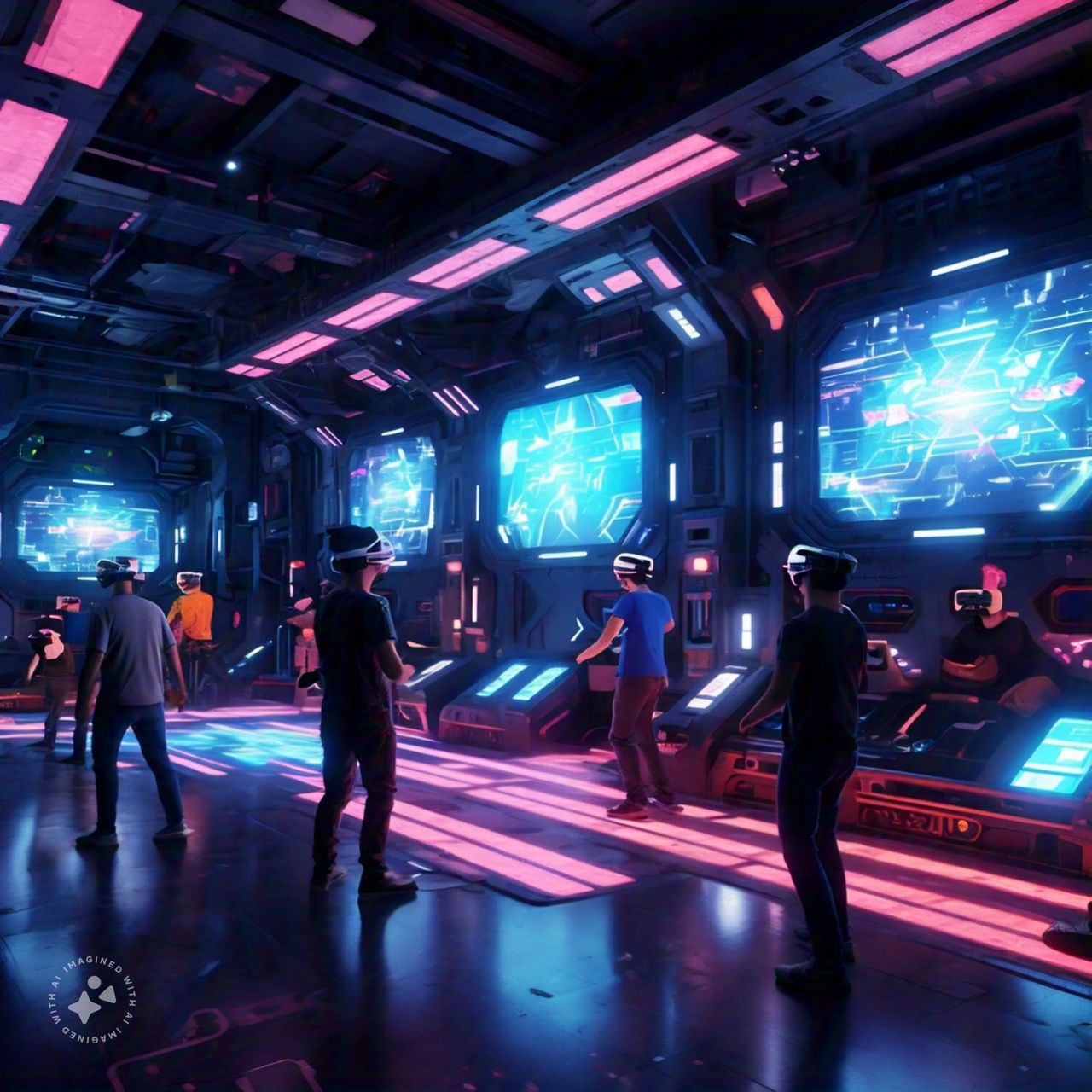Welcome to Sampean Game, your ultimate gaming hub! Here, we bring you the latest news, in-depth reviews, and expert tips and tricks from the gaming world. Whether you’re a casual gamer or a pro player, we’ve got exciting content to enhance your gaming experience. Explore Sampean Game now and discover everything you need to know about your favorite games!
As technology continues to evolve, the gaming industry is expanding its horizons to create experiences that go beyond the screen. Cross-reality (XR) games combine augmented reality (AR), virtual reality (VR), and real-life interactions to provide immersive and dynamic gameplay. This new genre is revolutionizing the way we interact with digital worlds, merging the physical and virtual realms in unprecedented ways.
Cross-reality games are transforming the gaming landscape by merging the digital and physical worlds. Through the innovative use of AR, VR, and real-life interactions, these games offer immersive, engaging, and dynamic experiences that appeal to a wide audience. Despite challenges such as high costs and technical limitations, advancements in hardware, AI integration, and creative design promise a bright future for XR gaming. As this genre continues to evolve, players can look forward to a new era of interactive entertainment that bridges the gap between reality and imagination.
What Are Cross-Reality Games?
Defining Cross-Reality
Cross-reality, or XR, is an umbrella term that includes AR, VR, and mixed reality (MR). XR games are designed to seamlessly integrate elements from all these technologies, allowing players to interact with both their physical surroundings and digital environments. In these games, players may use VR headsets for full immersion, AR-enabled devices to overlay digital objects onto real-world settings, or a combination of both to enhance interactivity.
Key Features of XR Games
The defining characteristic of XR games is their ability to blur the lines between reality and virtual worlds. These games utilize real-world data, such as geolocation, physical movement, or environmental factors, and combine them with virtual gameplay mechanics. They encourage players to move, explore, and interact with both their surroundings and digital objects, creating a unique hybrid experience.
The Technologies Behind XR Games
Augmented Reality (AR)
AR overlays digital elements onto the real world using devices like smartphones, tablets, or AR glasses. Games like Pokémon GO are prime examples of AR-based gameplay, where virtual creatures appear in real-world locations. AR in XR games adds layers of information or interactive objects to physical spaces, making the environment an integral part of the game.
Virtual Reality (VR)
VR immerses players in fully digital environments using headsets like the Oculus Quest or PlayStation VR. In XR games, VR allows for complete escapism, transporting players to fantastical worlds. When combined with AR, VR adds depth to gameplay, letting players switch between immersive environments and their physical surroundings.
Mixed Reality (MR)
MR combines AR and VR to create a more cohesive interaction between the physical and digital worlds. Players can manipulate virtual objects as if they were real, using devices like the Microsoft HoloLens. MR in XR games enables complex interactions, such as building virtual structures that seamlessly blend into the real-world landscape.
Popular Cross-Reality Games
Pokémon GO
Launched in 2016, Pokémon GO remains one of the most successful examples of AR gaming. By using GPS data, the game integrates real-world exploration with digital gameplay, encouraging players to discover Pokémon in their surroundings. The game exemplifies how AR can transform mundane locations into interactive gaming arenas.
Beat Saber with AR Enhancements
Although primarily a VR game, Beat Saber has inspired XR modifications that blend real-world surroundings with virtual gameplay. Players can customize their physical environment to interact with the game’s visuals and mechanics, creating a mixed-reality experience.
Minecraft Earth
Minecraft Earth brought the beloved sandbox game into the real world by using AR to place digital structures in physical spaces. Players could collaborate with others to build and explore their creations, merging real-life exploration with the game’s iconic blocky universe.
How XR Games Enhance Player Experience
Immersive Gameplay
By combining AR, VR, and real-life elements, XR games provide deeply immersive experiences that traditional games cannot match. Players can physically move around, interact with their environment, and experience a heightened sense of presence in the game.
Social Interaction
XR games often emphasize collaborative or competitive gameplay in shared physical spaces. Multiplayer modes enable friends or strangers to engage in real-time interactions, either in the same location or across different settings. Social XR games like Rec Room foster community and cooperation among players.
Physical Engagement
Unlike sedentary gaming experiences, XR games encourage physical activity. Whether it’s walking to different locations in an AR game or performing dynamic movements in VR, these games promote healthier gaming habits by incorporating exercise into entertainment.
The Challenges of Cross-Reality Gaming

Technological Limitations
Despite its potential, XR gaming faces technical challenges. High-quality AR and VR experiences require advanced hardware, which can be expensive and inaccessible to many players. Battery life, processing power, and compatibility issues further limit widespread adoption.
Privacy and Safety Concerns
The integration of real-world data in XR games raises concerns about privacy and safety. Location-based games may expose players to risks, such as trespassing or data breaches. Additionally, VR experiences can lead to accidents if players are unaware of their physical surroundings.
Development Costs
Creating XR games is resource-intensive, requiring a combination of AR, VR, and real-world interaction mechanics. The complexity of development and the need for cross-platform compatibility can lead to higher costs for developers, which may translate into more expensive games for consumers.
The Future of Cross-Reality Games
Advances in Hardware
The future of XR gaming is tied to the development of more accessible and affordable hardware. Lightweight AR glasses, wireless VR headsets, and portable devices are likely to become the norm, enabling more players to engage with XR games.
AI and Machine Learning Integration
Artificial intelligence will play a significant role in enhancing XR games. AI-powered systems can create more realistic interactions, adapt gameplay to individual players, and generate dynamic, context-sensitive experiences that blend seamlessly with the real world.
Broader Applications Beyond Gaming
XR technology has applications beyond entertainment. Educational XR games can teach players about history or science by overlaying digital information onto real-world landmarks. Similarly, XR training simulations can be used in fields like healthcare, engineering, and the military.
How to Get Started with XR Gaming
Choosing the Right Equipment
To experience XR games, players need compatible devices. VR headsets like the Meta Quest or PlayStation VR are ideal for immersive experiences, while smartphones and AR glasses are sufficient for AR-based games. Look for devices that support both AR and VR to explore the full range of XR gaming.
Exploring Available Games
Many XR games are available on app stores and gaming platforms. Start with popular titles like Pokémon GO, Beat Saber, or The Walking Dead: Saints & Sinners to experience the variety of gameplay mechanics XR offers.
Embracing the Hybrid Experience
For those new to XR gaming, hybrid games that incorporate both AR and VR elements can provide a comprehensive introduction. Look for titles that encourage exploration, creativity, and interaction to fully appreciate the potential of cross-reality games.
Conclusion
Cross-reality games are transforming the gaming landscape by merging the digital and physical worlds. Through the innovative use of AR, VR, and real-life interactions, these games offer immersive, engaging, and dynamic experiences that appeal to a wide audience. Despite challenges such as high costs and technical limitations, advancements in hardware, AI integration, and creative design promise a bright future for XR gaming. As this genre continues to evolve, players can look forward to a new era of interactive entertainment that bridges the gap between reality and imagination.







